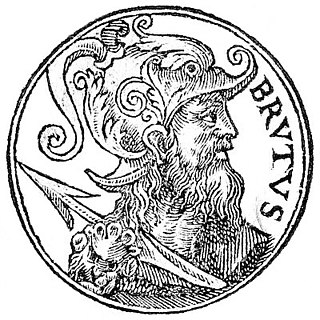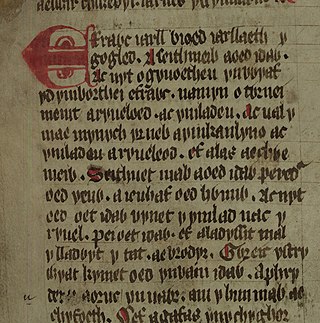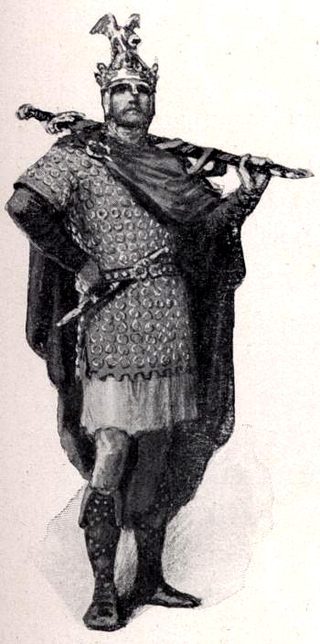Related Research Articles

Geoffrey of Monmouth was a Catholic cleric from Monmouth, Wales, and one of the major figures in the development of British historiography and the popularity of tales of King Arthur. He is best known for his chronicle The History of the Kings of Britain which was widely popular in its day, being translated into other languages from its original Latin. It was given historical credence well into the 16th century, but is now considered historically unreliable.

Brutus, also called Brute of Troy, is a mythical British king. He is described as a legendary descendant of the Trojan hero Aeneas, known in medieval British legend as the eponymous founder and first king of Britain. This legend first appears in the Historia Brittonum, an anonymous 9th-century historical compilation to which commentary was added by Nennius, but is best known from the account given by the 12th-century chronicler Geoffrey of Monmouth in his Historia Regum Britanniae.

Lud, according to Geoffrey of Monmouth's pseudohistorical History of the Kings of Britain and related medieval texts, was a king of Britain in pre-Roman times who founded London and was buried at Ludgate. He was the eldest son of Geoffrey's King Heli, and succeeded his father to the throne. He was succeeded, in turn, by his brother Cassibelanus. Lud may be connected with the Welsh mythological figure Lludd Llaw Eraint, earlier Nudd Llaw Eraint, cognate with the Irish Nuada Airgetlám, a king of the Tuatha Dé Danann, and the Brittonic god Nodens. However, he was a separate figure in Welsh tradition and is usually treated as such.

Beli Mawr was an ancestor figure in Middle Welsh literature and genealogies. He is the father of Cassivellaunus, Arianrhod, Lludd Llaw Eraint, Llefelys, and Afallach. In certain medieval genealogies, he is listed as the son or husband of Anna, cousin of Mary, mother of Jesus. According to the Welsh Triads, Beli and Dôn were the parents of Arianrhod, but the mother of Beli's other children—and the father of Dôn's other children—is not mentioned in the medieval Welsh literature. Several royal lines in medieval Wales traced their ancestry to Beli. The Mabinogi names Penarddun as a daughter of Beli Mawr, but the genealogy is confused; it is possible she was meant to be his sister rather than daughter.
Catellus was a legendary king of the Britons, as recounted in Geoffrey of Monmouth's work Historia Regum Britanniae. He came to power in 269 BC.
Nennius is a mythical prince of Britain at the time of Julius Caesar's invasions of Britain. His story appears in Geoffrey of Monmouth's History of the Kings of Britain (1136), a work whose contents are now considered largely fictional. In Middle Welsh versions of Geoffrey's Historia he was called Nynniaw.

Historia regum Britanniae, originally called De gestis Britonum, is a fictitious historical account of British history, written around 1136 by Geoffrey of Monmouth. It chronicles the lives of the kings of the Britons over the course of two thousand years, beginning with the Trojans founding the British nation and continuing until the Anglo-Saxons assumed control of much of Britain around the 7th century. It is one of the central pieces of the Matter of Britain.

Peredur is the name of a number of men from the boundaries of history and legend in sub-Roman Britain. The Peredur who is most familiar to a modern audience is the character who made his entrance as a knight in the Arthurian world of Middle Welsh prose literature.

Brut y Tywysogion is one of the most important primary sources for Welsh history. It is an annalistic chronicle that serves as a continuation of Geoffrey of Monmouth’s Historia Regum Britanniae. Brut y Tywysogion has survived as several Welsh translations of an original Latin version, which has not itself survived. The most important versions are the one in Robert Vaughan's Peniarth MS. 20 and the slightly less complete one in the Red Book of Hergest. The version entitled Brenhinoedd y Saeson combines material from the Welsh annals with material from an English source.
The Treason of the Long Knives is an account of a massacre of British Celtic chieftains by Anglo-Saxon soldiers at a peace conference on Salisbury Plain in the 5th century. The story is thought to be pseudohistorical as the only surviving records mentioning it are centuries later in the semi-mythological histories of the Historia Brittonum and the Historia Regum Britanniae. Though a popular cautionary tale in medieval Europe, there is no other historical evidence for The Treason of the Long Knives. Most historians interpret the story as a purely literary construction.
The Battle of Chester was a major victory for the Anglo-Saxons over the native Britons near the city of Chester, England in the early 7th century. Æthelfrith of Northumbria annihilated a combined force from the Welsh kingdoms of Powys and Rhôs, and possibly from Mercia as well. It resulted in the deaths of Welsh leaders Selyf Sarffgadau of Powys and Cadwal Crysban of Rhôs. Circumstantial evidence suggests that King Iago of Gwynedd may have also been killed. Other sources state the battle may have been in 613 or even as early as 607 or 605 AD.

Saint Tysilio was a Welsh bishop, prince and scholar.
Llefelys is a character in Welsh mythology appearing in the medieval Welsh tale Cyfranc Lludd a Llefelys. In the tale, Llefelys is king of Gaul while his brother Lludd is king of Britain. The tale appears in the Red Book of Hergest and the White Book of Rhydderch, the source texts for the Mabinogion, and embedded into various versions of the Brut y Brenhinedd, the Welsh adaptation of Geoffrey of Monmouth's Historia Regum Britanniae.
Pridwen was, according to the 12th-century writer Geoffrey of Monmouth, King Arthur's shield; it was adorned with an image of the Virgin Mary. Geoffrey's description of it draws on earlier Welsh traditions found in Preiddeu Annwfn, Culhwch and Olwen, and the Historia Brittonum. The shield is also named and described by Wace, Layamon, Roger of Wendover and Robert of Gloucester among other medieval writers, and it directly inspired the description of Sir Gawain's shield in Sir Gawain and the Green Knight.

King Arthur's family grew throughout the centuries with King Arthur's legend. The earliest Welsh Arthurian tradition portrays Arthur as having an extensive family network, including his parents Uther Pendragon and Eigyr (Igraine), wife Gwenhwyfar (Guinevere), nephew Gwalchmei (Gawain), brother, and several sons; his maternal lineage is also detailed, linking him to relatives such as his grandfather. This complex familial structure is simplified in the shared British and greater European tradition of chronicles and medieval romances influenced by Geoffrey of Monmouth's writings, which instead introduce new characters, such as Arthur's half-sisters including Morgan and Morgause, their children including Yvain and Mordred, and others. Arthur's lineage was later claimed by various rulers, especially the House of Tudor and Scottish clans, reflecting the enduring legacy of his familial ties in medieval and early modern genealogies.
Brenhinoedd y Saeson is the medieval title of a Middle Welsh annalistic chronicle. The name means 'the kings of the English'.

Brut y Brenhinedd is a collection of variant Middle Welsh versions of Geoffrey of Monmouth's Latin Historia Regum Britanniae. About 60 versions survive, with the earliest dating to the mid-13th century. Adaptations of Geoffrey's Historia were extremely popular throughout Western Europe during the Middle Ages, but the Brut proved especially influential in medieval Wales, where it was largely regarded as an accurate account of the early history of the Celtic Britons.

Lludd and Llefelys is a Middle Welsh prose tale written down in the 12th or 13th century; it was included in the Mabinogion by Lady Charlotte Guest in the 19th century. It tells of the Welsh hero Lludd Llaw Eraint, best known as King Lud son of Heli in Geoffrey of Monmouth's Historia Regum Britanniae, and his brother Llefelys.
A number of medieval chronicles of the history of Wales survive, notably the 9th century Historia Brittonum and the 10th century Annales Cambriae. These early chronicles are written in Latin, while from the 12th century, some are composed in Middle Welsh. The oldest surviving manuscripts of chronicles kept in the National Library of Wales, Aberystwyth date to the 13th century.

Gogmagog was a legendary giant in the Matter of Britain. According to Geoffrey of Monmouth's Historia Regum Britanniae, he was a giant inhabitant of Cornwall, who was thrown off a cliff during a wrestling match with Corineus.
References
- Brut y Brenhinedd (Llanstephan MS 1), ed. Brynley F. Roberts, Brut y Brenhinedd. Llanstephan MS. 1 version. Selections. Mediaeval and Modern Welsh series 5. Dublin, 1971. Extracts and discussion.
- Brut Tysilio, ed. A. Griscom, in The Historia regum Britanniæ of Geoffrey of Monmouth, ed. A. Griscom an J.R. Ellis. London, 1929; tr. Peter Roberts, The chronicle of the kings of Britain. Translated from the Welsh copy attributed to Tysilio. London, 1811; updated translation in Petrie's "Neglected British History" cited above; tr. A.S. San Marte, Brut Tysilio. Gottfrieds von Monmouth Historia Regum Britanniae und Brut Tysilio. Halle, 1854 (German translation).
- Geoffrey of Monmouth; Thorpe, Lewis (Ed.) (1966). The History of the Kings of Britain, New York: Penguin.